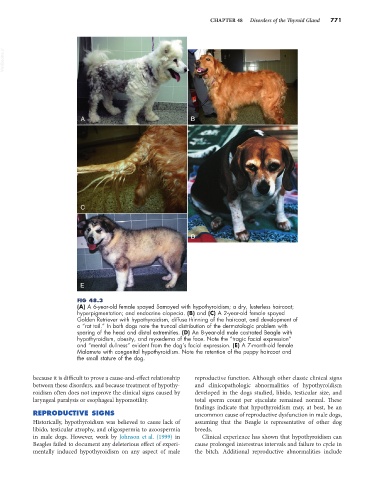Page 799 - Small Animal Internal Medicine, 6th Edition
P. 799
CHAPTER 48 Disorders of the Thyroid Gland 771
VetBooks.ir
A B
C
D
E
FIG 48.3
(A) A 6-year-old female spayed Samoyed with hypothyroidism; a dry, lusterless haircoat;
hyperpigmentation; and endocrine alopecia. (B) and (C) A 2-year-old female spayed
Golden Retriever with hypothyroidism, diffuse thinning of the haircoat, and development of
a “rat tail.” In both dogs note the truncal distribution of the dermatologic problem with
sparing of the head and distal extremities. (D) An 8-year-old male castrated Beagle with
hypothyroidism, obesity, and myxedema of the face. Note the “tragic facial expression”
and “mental dullness” evident from the dog’s facial expression. (E) A 7-month-old female
Malamute with congenital hypothyroidism. Note the retention of the puppy haircoat and
the small stature of the dog.
because it is difficult to prove a cause-and-effect relationship reproductive function. Although other classic clinical signs
between these disorders, and because treatment of hypothy- and clinicopathologic abnormalities of hypothyroidism
roidism often does not improve the clinical signs caused by developed in the dogs studied, libido, testicular size, and
laryngeal paralysis or esophageal hypomotility. total sperm count per ejaculate remained normal. These
findings indicate that hypothyroidism may, at best, be an
REPRODUCTIVE SIGNS uncommon cause of reproductive dysfunction in male dogs,
Historically, hypothyroidism was believed to cause lack of assuming that the Beagle is representative of other dog
libido, testicular atrophy, and oligospermia to azoospermia breeds.
in male dogs. However, work by Johnson et al. (1999) in Clinical experience has shown that hypothyroidism can
Beagles failed to document any deleterious effect of experi- cause prolonged interestrus intervals and failure to cycle in
mentally induced hypothyroidism on any aspect of male the bitch. Additional reproductive abnormalities include

